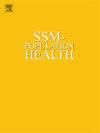Digital health literacy and trust in health information sources: A comparative study of university students in Japan, the United States, and India
IF 3.1
2区 医学
Q1 PUBLIC, ENVIRONMENTAL & OCCUPATIONAL HEALTH
引用次数: 0
Abstract
The rapid expansion of the Internet and social media has transformed health communication, highlighting the critical importance for digital health literacy - particularly during the “infodemics” of the COVID-19 pandemic. This study examined digital health literacy and online health information–seeking behaviors among university students - the digital native generation - in Japan, the United States, and India. A cross-national comparison across these culturally and technologically diverse countries provides insights into global variations in digital health literacy.
An online survey was administered to 1500 undergraduate students (500 per country) using the Digital Health Literacy Instrument (DHLI) to evaluate their ability in utilizing digital health information. DHLI scores were compared across countries, and associated factors were analyzed.
The mean age of participants was 20.6 years. DHLI scores were significantly higher in the US (3.10 ± 0.38) than in India (2.94 ± 0.38) and Japan (2.89 ± 0.42). While students generally demonstrated strong operational skills, many lacked sufficient ability to critically evaluate information and contribute self-generated content, indicating the need for targeted educational support. Importantly, trust in online health information sources, rather than mere usage, was strongly associated with higher DHLI scores.
These findings highlight the importance of enhancing individual skills in identifying credible sources and increasing the availability of trustworthy digital health content, particularly from public agencies and official social media platforms. Future research should explore cultural and systemic factors underlying cross-country differences to inform targeted strategies for improving digital health literacy globally.
数字健康素养与对健康信息来源的信任:日本、美国和印度大学生的比较研究
互联网和社交媒体的迅速发展改变了卫生传播,凸显了数字卫生素养的至关重要性,特别是在2019冠状病毒病大流行的“信息流行病”期间。这项研究调查了日本、美国和印度的大学生(数字原生代)的数字健康素养和在线健康信息寻求行为。对这些文化和技术多样化的国家进行跨国比较,可以深入了解数字卫生素养的全球差异。使用数字健康素养工具(DHLI)对1500名本科生(每个国家500名)进行了在线调查,以评估他们利用数字健康信息的能力。DHLI得分在不同国家之间进行比较,并分析相关因素。参与者的平均年龄为20.6岁。DHLI评分在美国(3.10±0.38)明显高于印度(2.94±0.38)和日本(2.89±0.42)。虽然学生们普遍表现出很强的操作技能,但许多人缺乏足够的能力来批判性地评估信息和贡献自我生成的内容,这表明需要有针对性的教育支持。重要的是,对在线健康信息来源的信任,而不仅仅是使用,与较高的DHLI分数密切相关。这些发现强调了提高个人技能在识别可靠来源和增加可信赖的数字健康内容的可用性方面的重要性,特别是来自公共机构和官方社交媒体平台。未来的研究应探索跨国差异背后的文化和系统因素,为提高全球数字健康素养的有针对性战略提供信息。
本文章由计算机程序翻译,如有差异,请以英文原文为准。
求助全文
约1分钟内获得全文
求助全文
来源期刊

Ssm-Population Health
PUBLIC, ENVIRONMENTAL & OCCUPATIONAL HEALTH-
CiteScore
6.50
自引率
2.10%
发文量
298
审稿时长
101 days
期刊介绍:
SSM - Population Health. The new online only, open access, peer reviewed journal in all areas relating Social Science research to population health. SSM - Population Health shares the same Editors-in Chief and general approach to manuscripts as its sister journal, Social Science & Medicine. The journal takes a broad approach to the field especially welcoming interdisciplinary papers from across the Social Sciences and allied areas. SSM - Population Health offers an alternative outlet for work which might not be considered, or is classed as ''out of scope'' elsewhere, and prioritizes fast peer review and publication to the benefit of authors and readers. The journal welcomes all types of paper from traditional primary research articles, replication studies, short communications, methodological studies, instrument validation, opinion pieces, literature reviews, etc. SSM - Population Health also offers the opportunity to publish special issues or sections to reflect current interest and research in topical or developing areas. The journal fully supports authors wanting to present their research in an innovative fashion though the use of multimedia formats.
 求助内容:
求助内容: 应助结果提醒方式:
应助结果提醒方式:


